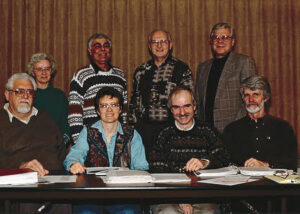Come with us as we look into the future ten years from now (2026), if the recommendations of the Future Directions Task Force are followed in their present form. Regional clusters of congregations have been asked to pick up the functions of Mennonite Church Canada which was disbanded in 2018.
The clusters were handed the roles of global witness, faith formation and developing their own worship resources. An executive minister was appointed to assist and manage these roles.
There will likely be no co-ordinated global witness, with all present 24 Witness workers now located in Africa, Asia, Europe and South America called back to Canada and disappearing into congregations here. There will be a reversal of “witness.” We will likely have zealous, fast-growing churches like the one in Ethiopia sending missionaries to Canada to revive our congregations in their vision for a global ministry.
Persons doing short-term mission assignments, if indeed they are picked up by the clusters, will have no particular orientation or training in the many unique cultures around the globe. These volunteers will essentially be on their own to orient themselves in a very short time, raising questions by the particular “nationals” as to their purpose for being there.
There will be no national assembly as such, where delegates from the area churches discuss current issues, where in a kind of grand family reunion fashion, we connect with each other in ways no other setting provides. Our vision and national purpose as a unique Anabaptist part of the 21st century church will inevitably suffer.
On the faith formation front, our Mennonite diaspora and eclectic manifestations of faith will likely take no unified form of drawing on and developing a modern Anabaptist identity. They will likely devolve into an each-to-his-own character and expression. Unless they are trained at one of our seminaries, pastors will likely lead their congregations on a path that mostly reflects their own personal orientation and background.
Some will even struggle with the name “Mennonite,” thinking it too restrictive and mostly cultural, similar to what our cousins the Mennonite Brethren are struggling with. Some of their more progressive, more evangelical congregations are dropping the “Mennonite” name and going for something more generic, like “Community Church.”
As to developing their own worship resources, these clusters will likely, in the same manner as faith formation, go a hundred different ways, many of them individualized to the particular congregation. They will likely draw on many different theological streams, some to the liberal left, others with a more evangelical flavour and purpose, others, more creative in nature, will strike a very local narrative.
The many musical resources and styles already practised in our congregations will only go more local, with a diminishing use of our own Mennonite hymnals and devotional resources. And as we noted in our last editorial, congregations, already challenged with shortfalls in budgets and expanding ministries and programs, are hardly in a position to develop serious resources, such as videos and Sunday school discussion guides.
In the broader communication field, unless the area churches, through these clusters pick up the $110,000 financial support MC Canada makes to this magazine, there will likely be no Canadian Mennonite as a print and digital product. There will be no village square providing a forum to discuss ongoing issues facing the national church, no telling of the many stories from all the provinces, no centre for family news as published in Milestones—births, deaths, marriages, baptisms. There will be no calendar to draw attention to special events across the country.
We submit again that the driving force behind this disbanding of MC Canada is financial—a budget shortfall this year of $300,000. That doesn’t seem to be the end of the world (or of a denominational centre), in a budget of more than $3 million.
There is no doubt we have the wealth. What we lack is the will, the vision. One wealthy donor just made a multi-million contribution to a Mennonite project. A recent letter writer suggested that, if each of our 30,000 members would contribute $10 each, we could easily close this gap.
Are we willing to give to save, not the structure, but the vision?
See also:







Leave a Reply
You must be logged in to post a comment.